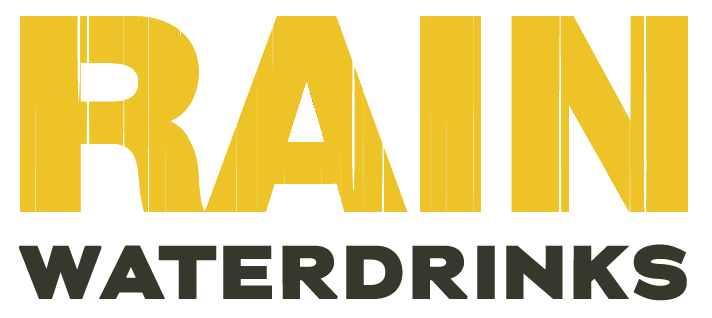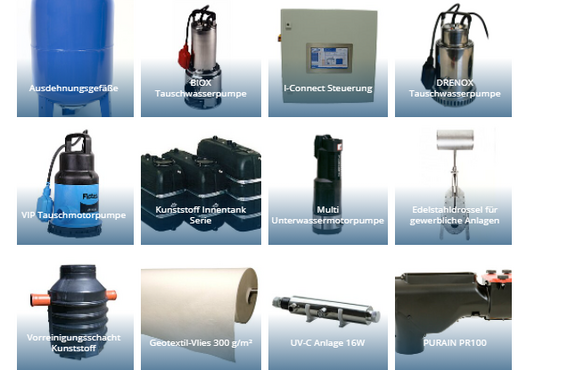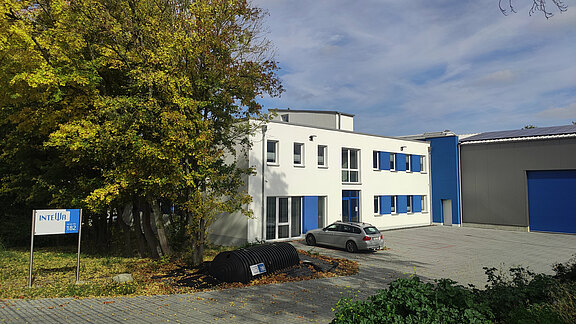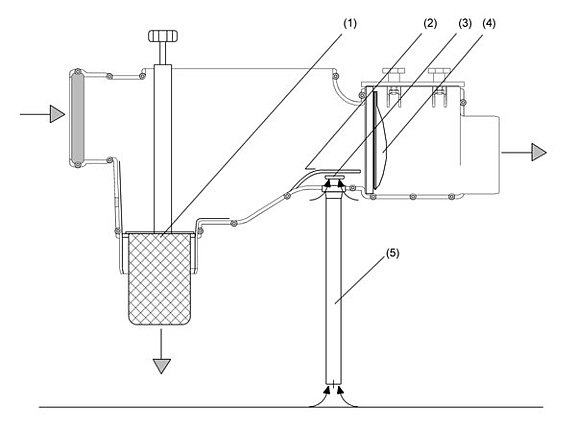New option for water treatment and grey water recycling
A new option for treating, disinfecting and reusing grey water, seawater, groundwater and wastewater is now available through membrane filtration. This technology offers up to 10 years service life from the filtration membranes and an energy requirement of less than 2.5 kWh / m³.
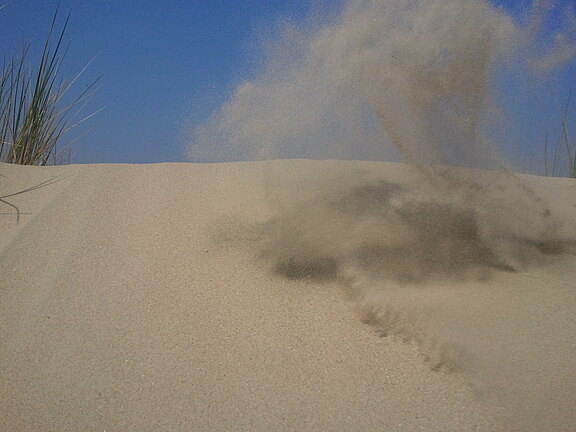
The necessity as well as the opportunities to save substantial amounts of potable water has greatly increased in recent years. In addition to the obvious measures such as economical taps and simply less water usage new opportunities and specialised technology make it possible to now effectively process already used contaminated water. After being treated the processed water can be used in place of precious drinking water for:
- toilet flushing, irrigation, cleaning purposes, washing machine, cooling, commercial applications etc.
- in single and multiple family dwellings, sporting complexes, commercial buildings, industrial property etc.
The contaminated water for treatment can be obtained from numerous water resources:
- Grey water from households, run-off from wastewater treatment systems, surface water, groundwater, industrial wastewater etc.
Water treatment and reuse brings a whole range of advantages with it.
Benefits to consumers:
- Saves increasing municipal drinking water and sewage costs,
- less or no dependency on water supplier,
- regular water inflow source,
- reliable water quality
Benefits to communities:
- Reduction of expenditure for flood protection / flood prevention,
- reduction of costs in sewer construction,
- sewer renewal and in operating treatment plants,
- possible savings in development costs of new residential areas,
- securing the groundwater supply and thereby saving the drinking water supply.
The enormous potential for localised water treatment has not yet been fulfilled because of the fact that safe, existing water treatment technologies are too expensive to buy and maintain. Therefore, simpler and affordable, and even more powerful water treatment methods are required.
Any new system must fulfil the minimum requirements for water quality and the resulting processed water should not pose a health hazard to end users, communities or to countries as a whole.
Market requirements arranged as per their priority:
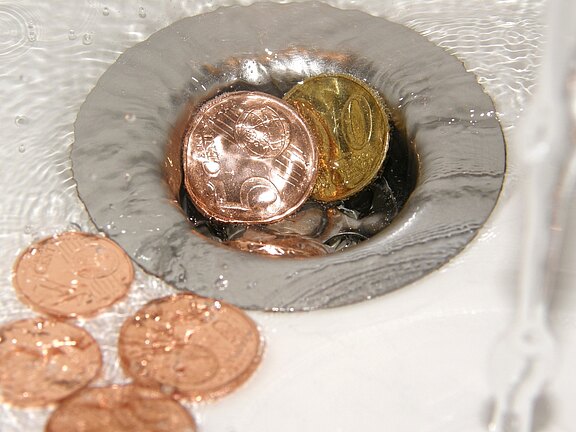
- No solid material, no odour, low turbidity (clarity)
- DIN 19650 quality requirements for irrigation water
- Low bacterial contamination, corresponds with EU Bathing Water Directives
- USA, UK (BSRIA) non-detectable coliform level
- Minimum proportion of chlorine (USA, CA + other countries)
- Corresponds with EU Drinking Water Directive
If the world’s highest standard is applied to organic contamination and filtratable materials, the processed water must meet the following quality parameters:
| BOD5 / BSB | < 5mg/l |
| TSS / AFS | filtratable substances < 10mg/l |
| Escherichia Coli | non-verifiable / 100 ml |
| Total coliform bacteria | non-verifiable / 100 ml |
In Canada, USA and Japan a minimum chlorine content (> = 0.5 mg / l) is requested in the treatment of processed water.
In recent years membrane technology has been established as a promising technique to provide hygienic and clean water. In membrane filtration, depending on the membrane pore, the finest dissolved particles as well as bacteria and virus are filtered out as with a sieve. To be effective a membrane pore size of 0.1 to 1 must be used.
In the past the disadvantages of membrane filtration were:
- High power consumption due to a differential pressure requirement > 1 bar
- Membrane fouling increasing the necessary differential pressure
- Fats and oils clogging the membrane
- Restricted back-flushing pressure with membrane plates
- High maintenance costs due to specialised chemical cleaning by trained personnel
- Short service life of membrane
- High cost of membrane filters
Most of the problems can be easily solved by optimizing pre-filtration, biodegradation and a new membrane generation. This is explained in the following example:
| (1) Removable filter sieve for trapping coarse dirt < 1 mm |
| (2) Emergency overflow |
| (3) Skimmer overflow for extracting surface dirt |
| (4) Non-return valve for protecting the system from backflow, small animals and insects |
| (5) Overflow siphon for extracting ground sediments |
Prefiltering and biodegradation
Debris particles larger than 1 mm are trapped in a removable filter sieve. The built-in non-return valve prevents the backflow of water and small animals and mosquito larvae from entering the tank.
After coarse filtration the water is channelled into the tank containing the membrane bioreactor. Here continuous biodegradation is carried out by the bacteria in the aerated fluidized bed. A few weeks after start-up these bacteria automatically settle on growth bodies, which are special floats designed with a large surface area. The required air originates in the membrane station and ensures optimum oxygen supply to the biological helpers, the bacteria. This technology has been used successfully in wastewater treatment systems for years. The excess sludge is automatically cleaned by the movement of the float and its special shape and thus virtually does not require any maintenance.
With each overflow of tank the ground sediments are automatically extracted through a suction overflow in the pre-filter. If the overflow has reached its maximum capacity, the water overflows through the integrated skimmer and thereby cleans the floating debris (foam, grease, oil) from the surface of the water.
This leads to a continuous improvement in water quality within the storage tank. Except for a regular, manual emptying of the filter the technology is basically maintenance-free and inexpensive to set up.
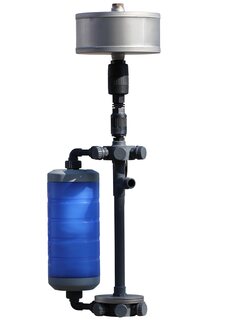
Membrane filtration
As illustrated, the membranes are mounted on a type of station. With symmetrical arrangement of suction the installed pump uniformly draws the water through the membranes for cleansing and sends it via the permeate hose to the clean water tank. The membrane is automatically cleaned (from a back-flushing container located above the pump) at regular intervals to guarantee a long, high flow operating life. In addition to this, the membrane is periodically flushed with air in order to free the fibres from deposits.
For this purpose the membrane station has a hose connection, which a blower is connected to. The air is uniformly distributed to the connected membranes via an insert with symmetrical distribution terminals and at the same time it supplies oxygen to the bioreactor. Multiple AQUALOOP membrane stations are connected in parallel for larger water treatment plants.
A controller is provided for every membrane station. This fully automatically controls the water treatment plant. The operating status can be easily read from an illuminated LCD display. The controller has several advantages:
- Built-in electrical regulation of pumps, depending on the number of membranes used, saves energy and increases service life
- Smart controller adjusts the required quantity as per the need for saving energy
- Automatic back-flushing mode for low-maintenance operation
- Automatic sludge disposal to minimize maintenance
Special organic fibres are used for ultra- and micro-filtration in water and wastewater treatment. The basic principle of this filtration is the use of organic porous hollow fibre membranes with micro pores as a filter medium. The fibres have an external diameter of less than 1 mm. Hundreds of fibres are bundled together creating sufficient surface area and to ensure a constant flow rate. Regular chemical cleaning is not necessary. Advantages of the new membrane are:
- The membrane fibres are permanently hydrophilic, meaning they are immediately functional when they come into contact with water, drying does not damage the membrane
- back-flushing with up to 3 bar
- Special additives in the PE membrane prevent the growth of micro-organisms - suppression 99.97 % according to Japanese Standard JIS Z 2801
- The membrane is resistant to acid, alkaline and chlorine-containing detergents
The pressure differences and energy requirement for filtration are very low while working with very large membrane surfaces. The model plants showed an energy consumption of less than 2.5 kWh / m³. The expected service life of a membrane is now up to 10 years compared to 2 years with conventional technology.
Summary
Although the membrane filter has always provided hygienic and clean water, up to now it has hardly been used in the treatment of household grey water for reusing water as processed water in households, for example. The reasons for this have been high purchase and maintenance costs. But a newly developed method is now available to overcome these previous disadvantages. In this new method water with severe organic contamination is treated mechanically with a pre-filter and biologically in a fluidized bed. The pre-filter contains further purification functions such as extraction of ground sediment and surface debris at the same time. The pre-cleansed water is then purified through special hollow fibre membranes. The combination of membrane surface, material, back-flushing and air cleaning leads to clean treated water from a membrane with a service life of up to 10 years.
The huge potential of treating water economically as well as hygienically for further use has just materialized with the development of this new method.

